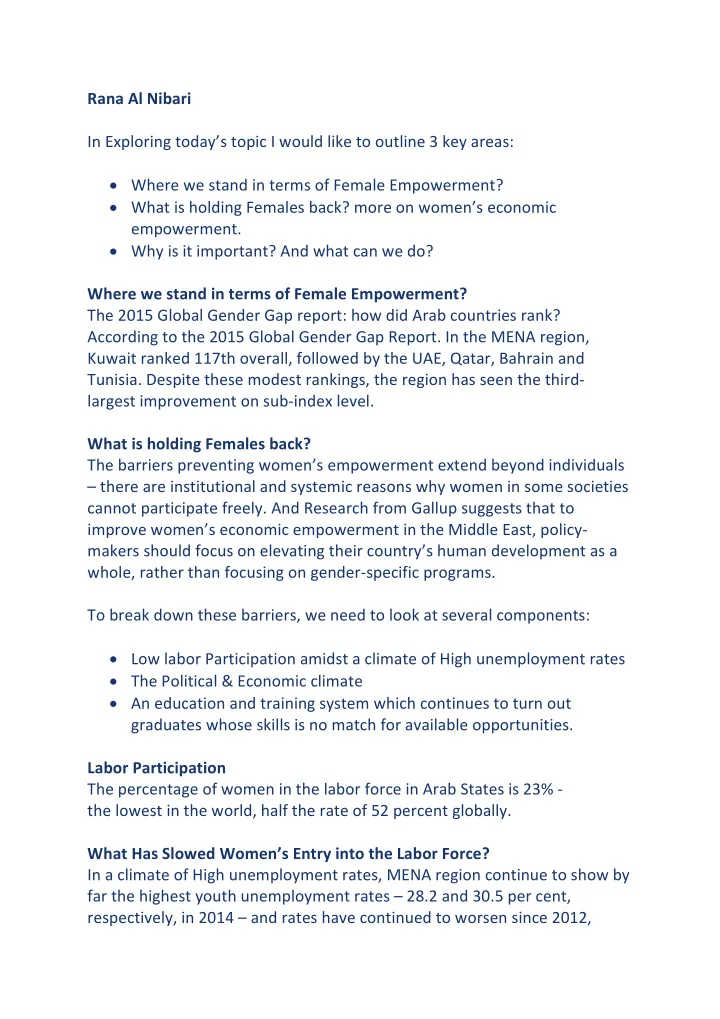

Rana Al Nibari In Exploring today’s topic I would like to outline 3 key areas: • Where we stand in terms of Female Empowerment? • What is holding Females back? more on women’s economic empowerment. • Why is it important? And what can we do? Where we stand in terms of Female Empowerment? The 2015 Global Gender Gap report: how did Arab countries rank? According to the 2015 Global Gender Gap Report. In the MENA region, Kuwait ranked 117th overall, followed by the UAE, Qatar, Bahrain and Tunisia. Despite these modest rankings, the region has seen the third- largest improvement on sub-index level. What is holding Females back? The barriers preventing women’s empowerment extend beyond individuals – there are institutional and systemic reasons why women in some societies cannot participate freely. And Research from Gallup suggests that to improve women’s economic empowerment in the Middle East, policy- makers should focus on elevating their country’s human development as a whole, rather than focusing on gender-specific programs. To break down these barriers, we need to look at several components: • Low labor Participation amidst a climate of High unemployment rates • The Political & Economic climate • An education and training system which continues to turn out graduates whose skills is no match for available opportunities. Labor Participation The percentage of women in the labor force in Arab States is 23% - the lowest in the world, half the rate of 52 percent globally. What Has Slowed Women’s Entry into the Labor Force? In a climate of High unemployment rates, MENA region continue to show by far the highest youth unemployment rates – 28.2 and 30.5 per cent, respectively, in 2014 – and rates have continued to worsen since 2012,
particularly for young women. The second important demand factor relates to the dominant pattern of economic growth in MENA, which relies on a large proportion of public sector jobs. With the share of public sector employment shrinking in many countries, the public sector will no longer remain an important source of jobs for women in the future. Economic & Political climate [Economic growth in the MENA is stagnant. Low oil prices, conflicts, and the global economic slowdown make short-term prospects of recovery unlikely. Conflict has severely hurt the economies of Yemen, Iraq and Syria and has resulted in a humanitarian catastrophe, mass displacement of people and destruction of homes, and infrastructure. Education If you were asked to name countries where women vastly outnumber men in higher education, Qatar has one of the highest rates on the planet, according to the most recent figures compiled by the World Bank where nearly 7X as many women as men are enrolled in university, In discussing the Quality of education we find that in most of the Arab region, K-12 education concentrates on route learning or memorization rather than teaching 21st century skills relevant to the need in the future. Which Includes leadership, teamwork, analytical and critical thinking, innovation and creativity. Why is it important? Gender inequality holds back a country’s economic performance, impedes a country’s ability to draw on its best talents, and they ultimately undermine economic growth and productivity, reduces development prospects, good governance, and the effectiveness of society’s institutions. All Stakeholders must acknowledge the potential for growth and prosperity that can be achieved when women are included And what can we do? 1 Reform of labour laws and regulations that create better incentive for job creation in the private sector. REDUCING THE CHALLENGES FACED BY SMES AND ENTREPRENEURS AS A WAY FORWARD
2 Supportive Infrastructure such as a well-functioning childcare market which allow them to combine work and family responsibilities 3 Significant investment in women’s education & capacity building: Accelerate women's economic participation and entrepreneurship development in the region. EXAMPLE of Entrepreneurship Development in the region: INJAZ through our experiential education programs functions in this domain. We aim to build entrepreneurs, from an early age, by exposing them to hands on learning. Our role remains largely unquantified, however more and more we see Policy makers understanding the importance of our contribution. Similarly, I see so many people in this room that can make a difference. Conclusion There is a great opportunity to collaborate and build multi stakeholder approach to promote empowerment.
Recommend
More recommend